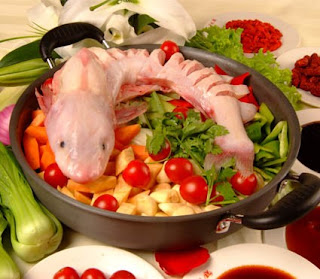Chapter Six
Chongqing: Hotpot Feast
Chongqing's city center is filled with restaurants and food stalls where you can pick up a cheap and filling meal for less than RMB10. Local specialties here include dumplings and pickled vegetables and, different from many other Chinese cuisines, Chongqing dishes are ideal for the solo diner- arriving in small individual sized portions.
This is where the HOTPOT originated and Chongqing residents are still very keen on their native dish, tucking in even when the sun is shining. Besides, hotpot enjoys a long history in China, for example, Chongqing hotpot has been around for over 100 years, since the early middle of the Qing Dynasty.
As a natural neighbor of Sichuan Province, the taste and flavor of Chongqing's food shares many similarities with that of Sichuan cuisine, with the emphasis on hot and spicy dishes. It is widely held that Chongqing dishes are somewhat heavier in taste and flavor than Sichuan dishes.
Hotpot: hot, hot, hot!
The most renowned and ubiquitous Chongqing dish is spicy hotpot. Nowadays, it is a very popular local flavor and can be found at every corner of the city, even all through the country. The most representative and famous types of Chongqing Hotpots are just following—
 |
| Yuanyang hotpot |
Cattle-gut Hotpot: Hotpots are the traditional famous course of Sichuan, of which Chongqing hotpot is specially noted, characterized by hotness, heavy flavors and dense soup. The traditional Chongqing hotpot's materials include cattle guts, cattle waists, beef and other vegetables, being a real self-help course.
Yuanyang Hotpot: Yuanyang hotpot is characterized by its unique flavor. In fact, Yuanyang hotpot is a mixture of the hot soup of traditional cattle-gut hotpot and the bree of mum hotpot. Thus it is honored Sichuan Innovative Hotpot. The pot is divided into two parts by a copper slice in the middle. One side is the container of hot soup, the other side is bree. The option of hotpot's materials is decided at your will.
 |
| Ma La Tang |
Ma La Tang, with various raw ingredients cooked in a communal pot of steaming stock blended with spices, originated in Sichuan's largest city, Chongqing. The double-sided soup pot, placed on a central table burner, is the focal point of the meal. Ingredients include fresh sliced abalone, sea cucumber, hog tendon, Beijing cabbage and beef dumpling, prawn, carp fish fillet, bean curd, chicken fillet and vegetables. The excellent dipping mixture of sesame oil, chili sauce, peanut sauce, chopped chilies and garlic combine to make magic. Savory titbits are appetizingly tasty -- egg coated glutinous square, crispy spring roll, fried buns, eight treasure black rice and water chestnut jelly. Diners cook their food right at the table in steaming Ma La Tang, a savory broth blended with the spices found in abundance in Sichuan.
Chongqing Local Snacks
In terms of local snacks, the must-try delicacies are Maoxuewang (a dish stewed with the dried blood cubes of chicken and duck, along with cubed tripe with spicy sauce), Chaoshou (meat dumplings with spicy sauce), Matuan (fried glutinous rice balls with sweet stuffing) and Jisi Liangmian (cool noodles with chicken shreds).
For the best places to try Chonqing's street food, we particularly recommend Nanbin Rd., Jiefangbei area, Yangjiaping area, Nanfang Huayuan, Quanshuiji Street, Three Gorges Square and Ciqikou.
 |
| Jiangtuan fish |
Besides the hotpot, snacks in Chongqing also make this city as a "capital of food". It is hard to describe the amazing feeling except you have tasted them. Below are some general introduction of these delicious snacks.--
Jiangtuan Fish: Since Chongqing is located along Jialing River, it is abundant in varieties of aquatic products. Among them, a local fish, Jiangtuan fish, also called big-head fish, is probably the best. The steamed fish, retaining all the essence, will definitely leave a deep impression on anyone that has sampled it.
Fuqi Fei Pian: it is made of thinly sliced beef, bovine lung or tongue seasoned with chili oil.
Sliced Meat with Crispy Rice: Sliced meat with crispy rice is a major dish in Chongqing. The meat tastes soft and tender while the rice is crispy, forming a sharp contrast with the former.
 |
| Mapo Bean Curd |
Spicy Diced Chicken (Kung Pao Chicken): Spicy Diced Chicken is cooked by frying diced chicken, dry red pepper and golden peanuts. Spicy Diced Chicken is as popular among Westerners as Mapo Bean Curd.
--In a word, are you ready to taste all these hot (spicy) & hot (popular)--hot food in Chongqing? I believe, the first sign you see them, you’ll fall in love with them: its attracting smell, its delicate look…Whatever, come on, my friend!

No comments:
Post a Comment
Thanks for your comment and welcome to China!